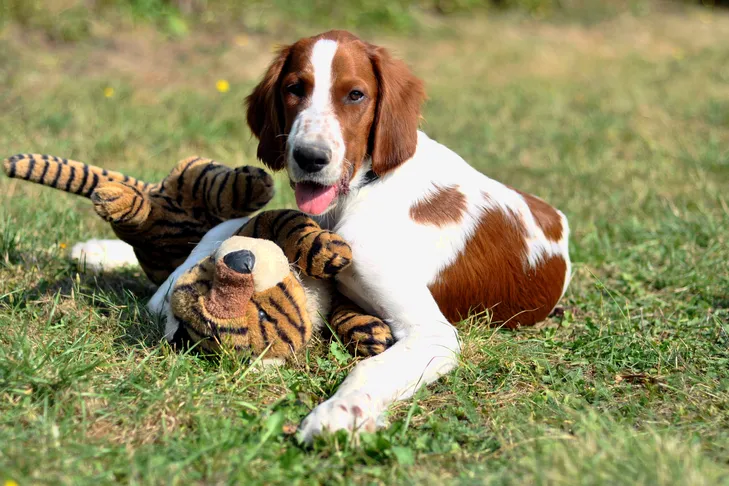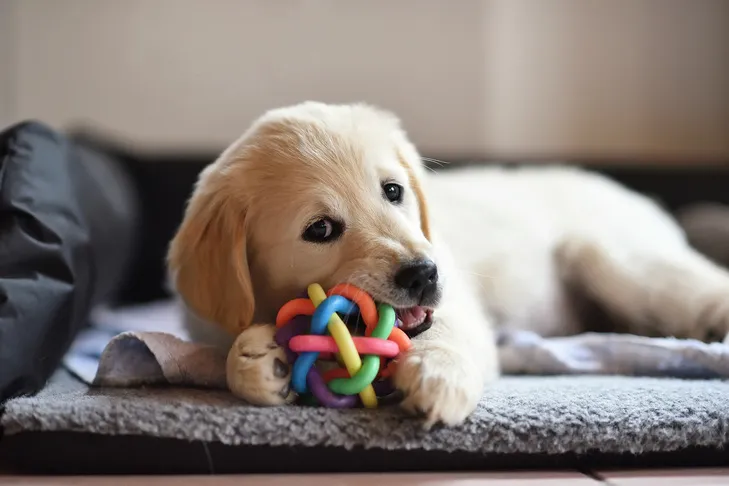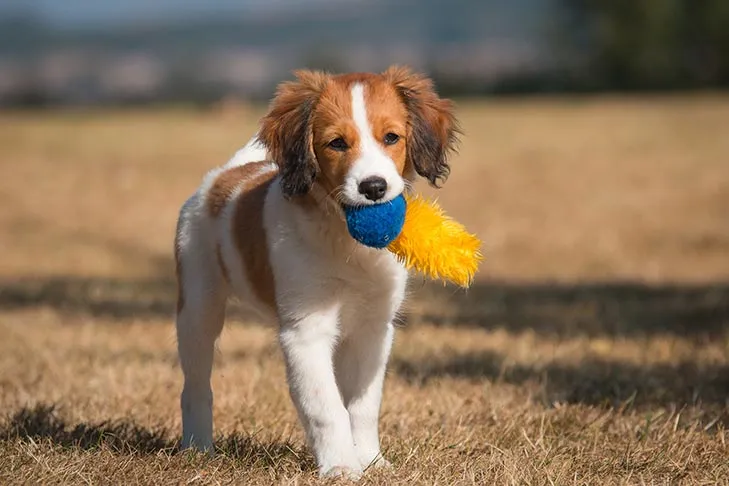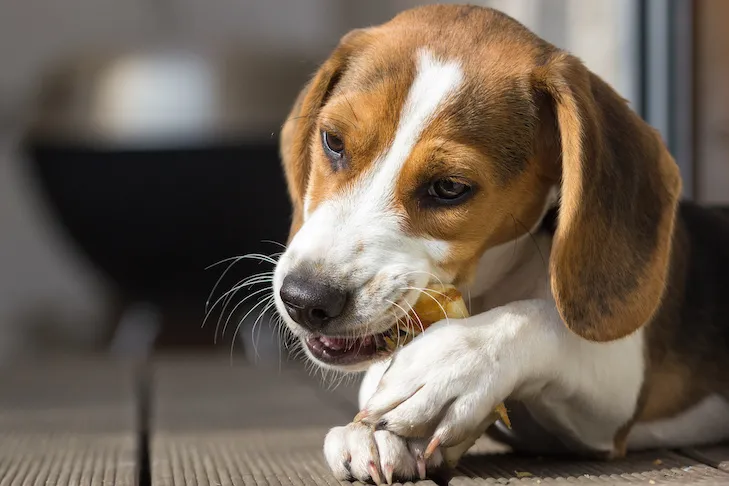Welcoming a large breed puppy into your home is an exciting adventure, full of joy and playful moments. However, it also comes with unique challenges, especially when it comes to their powerful chewing instincts. Choosing the right toys, particularly during the teething phase, is crucial not only for their development but also for preserving your furniture! This guide will help you navigate the world of puppy toys, focusing on the specific needs of large breed puppies to ensure a happy, healthy, and less destructive chewing experience. Ultimately, the right dog toy for your puppy depends on their individual personality, activity level, and chewing habits. However, for large breeds, durability is often the top priority.
Benefits of Puppy Playtime for Large Breeds
Playtime is more than just fun; it’s a vital component of a large breed puppy’s development. Puppies have a critical socialization window that typically begins when they’re 3 weeks old and continues until they’re roughly 14 weeks. The interactions during this timeframe play an integral role in building your puppy’s confidence and serve as the basis of their interactions throughout their lifetime. While many new dog owners might rush to the dog park, eager to start socialization early, it’s important to remember that socialization starts at home, often through guided play sessions.
 An Irish Red and White Setter puppy laying in the grass with a red stuffed toy.
An Irish Red and White Setter puppy laying in the grass with a red stuffed toy.
It’s important to remember that while exercise is crucial, you don’t want to overdo it with a large breed puppy. Excessive strenuous activity can hurt a puppy’s growth plates, which are still developing, and even lead to injury. Targeted play sessions, perhaps with a durable fetch toy in the yard, are often better than hours of intense exercise. Remember, the benefits of playing with your puppy go both ways. It’s not just about boosting your dog’s confidence and shaping their character; it’s also about building the trust between you and your dog that’s key to a lifetime bond. For large breeds, this bond is even more important, as their size and strength necessitate excellent communication and respect.
Soothing Sore Gums: Essential Teething Toys for Large Breed Puppies
Every puppy owner knows the difference between regular chewing and teething. Chewing is a natural behavior dogs use to relieve boredom or pass the time. Teething, however, is when a puppy’s sore gums and impacted teeth nearly become too much to bear, prompting them to chew on anything from furniture legs to drywall. This instinct is particularly strong and potentially destructive in large breed puppies, whose powerful jaws can inflict significant damage quickly. This is where dedicated Teething Toys For Large Breed Puppies become indispensable.
When selecting a teething toy for your large breed puppy, look for one that will offer both comfort and entertainment while being able to withstand their formidable chewing power. Consider purchasing best tough chew toys for dogs made of heavy-duty nylon, hard rubber, or specially designed durable plastics. Toys made with these robust materials are less likely to break apart after a few play sessions, providing lasting relief and preventing your dog from taking out their growing pains on inappropriate household items. You need a toy that can stand up to the challenge of a rapidly developing, strong jaw.
Beyond Teething: Other Essential Toys for Large Breed Puppies
While teething toys are critical, large breed puppies also benefit immensely from a variety of other toys that stimulate them mentally and physically.
Puzzle Toys for Mental Stimulation
Dr. Stanley Coren, the author of the landmark book “The Intelligence of Dogs,” notes that a dog’s intelligence is 51% breed, 49% environmental. This means that while breed plays a role, mental stimulation from their environment can significantly boost their intelligence. So it’s never too early (or too late) to start boosting your large breed puppy’s brain power. Puzzle toys that rely on finding treats or locating a coveted toy can offer your dog an opportunity to explore their surroundings and build their problem-solving skills. These are especially good for active large breeds who need their minds engaged, not just their bodies.
 A Golden Retriever puppy happily chewing on a yellow ball while resting in a soft dog bed indoors.
A Golden Retriever puppy happily chewing on a yellow ball while resting in a soft dog bed indoors.
You may look for puzzle toys with pull-out drawers, sliders, and rotating parts that you can fill with high-value treats, offering an extra incentive to engage your puppy. There are also puzzle toys with noise-making features, such as rattlers and squeakers. Some even let you record your own voice! Since many puzzle toys come in varying stages of difficulty, you may want to purchase a toy that allows you to adjust the difficulty based on your dog’s abilities. Soon, a puzzle that once took your large breed puppy hours to crack could be solvable in no time, showcasing their impressive learning capacity. Engaging their minds is key to preventing boredom and destructive behavior.
Comfort Toys for Adaptation
In the days and weeks after bringing a new puppy home, it’s understandable that they might miss their mother and littermates. Unfortunately, this could lead to whining, pacing, and other symptoms of stress, which can be particularly pronounced in a large breed puppy adjusting to a vast new environment. Thankfully, there are many comfort toys designed to help your puppy adapt to their new home. For example, some plush toys emit a sound similar to their mother’s heartbeat, helping them sleep through the night. Other comfort toys include plushies with beads that heat up in the microwave and offer a soothing, warm sensation.
 A Nederlandse Kooikerhondje puppy outdoors, holding a toy in its mouth.
A Nederlandse Kooikerhondje puppy outdoors, holding a toy in its mouth.
You may choose to purchase a toy specially designed for comfort if your large breed puppy struggles to sleep through the night, experiences separation anxiety, or needs help adjusting to a new environment. Comfort toys can also be helpful if you’re crate training your dog and hope to create a positive association. While these toys can offer much-needed comfort, avoid leaving them with your dog for extended periods unsupervised, especially if your large breed puppy is a strong chewer. For example, if your dog relies on a toy with an artificial heartbeat to sleep, remove it from their bed once they start snoozing. That way, they won’t wake up and start chewing on it and potentially damage it or ingest small parts.
Dental Toys for Oral Health
Large breed puppies can also benefit significantly from dental toys, which can help promote good dental health and stave off dental disease early in life. Considering their long lifespans and potential for expensive veterinary care, proactive dental hygiene is a wise investment. Search for dental toys that come with ridges, nubs, or uneven surfaces. These features help dislodge bits of food stuck between your young dog’s teeth, preventing decay and that dreaded puppy breath. There are also flavored dental toys that encourage your dog to chew, making oral hygiene a more enjoyable experience. Some toys also allow for the insertion of dental treats, though these items are generally sold separately.
As with any toys that your large breed puppy will gnaw on, be sure to choose best dog toys for dogs that chew through everything made of durable, non-toxic materials that won’t break apart easily. Large breeds have very strong jaws, and a flimsy dental toy will quickly be destroyed. If you notice rips, tears, or deep punctures in any toy, throw it out immediately. You don’t want to risk your puppy ingesting any small parts, which could lead to choking or internal obstructions. This is especially important for toys for aggressive chewing dogs uk which must be exceptionally robust.
 A young beagle chewing on a dog dental treat, demonstrating good oral hygiene practices.
A young beagle chewing on a dog dental treat, demonstrating good oral hygiene practices.
Always Supervise Your Large Breed Puppy During Playtime
Even if you’ve seen your large breed puppy play with the same toy dozens of times, it’s always a good idea to supervise the activity. Large breed puppies have incredibly sharp teeth and strong jaws, and you don’t want a day of play to turn into a night at the vet. Even a seemingly small puncture in a toy, especially with the power of a large breed’s bite, could cause foam, stuffing, or other materials to come loose, posing the threat of bowel obstructions. Always prioritize safety when choosing best chew toys for tough chewers and ensure they are appropriate for your puppy’s size and chewing style.
Supervising your puppy’s play sessions can also be a great opportunity to teach and brush up on basic commands, such as “leave it,” “drop it,” and “come here.” These commands are incredibly important for large breeds, whose size means they need excellent impulse control. Plus, can you name anything cuter than watching a large breed puppy play with their favorite toy? Providing the right best toys for tough chewers dogs is an investment in their health, happiness, and your peace of mind.
Conclusion
Selecting the appropriate teething toys for large breed puppies is a crucial step in ensuring their healthy development and preventing destructive chewing habits. From durable rubber teething toys to stimulating puzzle toys, comforting plushies, and beneficial dental chews, a diverse toy box will cater to all aspects of your growing companion’s needs. Always prioritize safety, durability, and appropriate sizing when making your selections, and remember that supervised playtime is key. By investing in the right toys and engaging in thoughtful play, you’re not just providing entertainment; you’re fostering a well-adjusted, confident, and happy large breed puppy, strengthening the bond you share for years to come.
